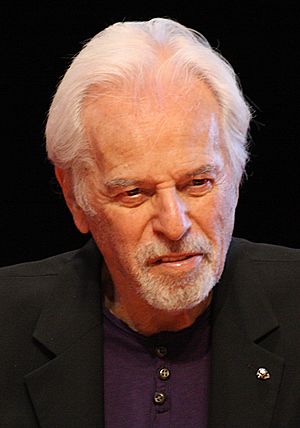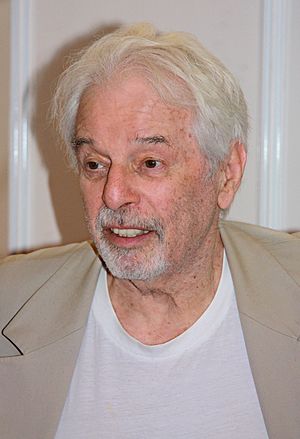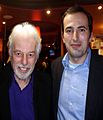Alejandro Jodorowsky facts for kids
Quick facts for kids
Alejandro Jodorowsky
|
|
|---|---|

Jodorowsky in 2011
|
|
| Born |
Alejandro Jodorowsky Prullansky
17 February 1929 Tocopilla, Chile
|
| Citizenship |
|
| Alma mater | University of Chile Paris-Sorbonne University |
| Occupation |
|
| Years active | 1948–present |
| Movement | Panic Movement |
| Spouse(s) |
|
| Children | 5, including Brontis, Axel and Adán |
| Relatives | Alma Jodorowsky (granddaughter) |
Alejandro Jodorowsky Prullansky (born February 17, 1929) is a Chilean and French filmmaker. He is famous for his unique and imaginative movies that are often described as avant-garde, which means they experiment with new and unusual ideas.
Jodorowsky is best known for his films El Topo (1970), The Holy Mountain (1973), and Santa Sangre (1989). His work is loved by fans of cult cinema. His movies are filled with dream-like, surreal images and explore ideas about mysticism and spirituality in a bold way.
Contents
Early Life and Career
Childhood in Chile
Alejandro Jodorowsky was born in the small coastal town of Tocopilla, Chile. His parents were Jewish immigrants from Ukraine. Jodorowsky had a difficult childhood and did not feel very close to his family. He also felt like an outsider in his town.
When he was nine, his family moved to the city of Santiago. He loved to read and began writing poetry. He published his first poem when he was only sixteen. He briefly went to the University of Chile but left to follow his passion for the theater. He even worked as a clown in a circus before starting his own theater group in 1947.
Move to Paris and the Panic Movement
In the early 1950s, Jodorowsky moved to Paris, France. There, he studied mime (acting without words) with the famous teacher Étienne Decroux. He even toured the world with the well-known mime artist Marcel Marceau.
In 1962, Jodorowsky co-founded the Panic Movement with other artists. This was a group that created shocking and absurd performance art. They wanted to challenge people's ideas about art and reality. During his time in Mexico, he also became interested in Zen Buddhism and studied with a monk named Ejo Takata.
Film Career
First Films
In 1967, Jodorowsky directed his first feature film, Fando y Lis. The movie was so unusual and shocking to audiences at the time that it caused a riot at a film festival in Mexico and was later banned there.
His next film was the acid western El Topo (1970). It became a huge success as a "midnight movie" in the United States. Midnight movies were films shown late at night that attracted audiences looking for something different. John Lennon of The Beatles loved the film so much that he convinced his manager, Allen Klein, to give Jodorowsky $1 million to make his next movie.
The Holy Mountain
With the funding from Klein, Jodorowsky created The Holy Mountain (1973). This film is a colorful and surreal adventure about a group of powerful people on a quest for enlightenment. It is filled with strange and beautiful imagery inspired by spirituality and alchemy.
However, Jodorowsky and Klein had a major disagreement. As a result, Klein, who owned the rights, refused to let El Topo and The Holy Mountain be shown for over 30 years. Despite this, the films became legendary in the world of underground cinema.
The Unmade Dune Project
In 1974, Jodorowsky was asked to direct a movie based on the famous science fiction novel Dune. He had a grand vision for the film. He wanted the artist Salvador Dalí and the actor-director Orson Welles to be in it. He also hired amazing artists like H. R. Giger and Mœbius to design the look of the movie.
Jodorowsky's script would have made a 14-hour film. The project was too big and expensive for any studio to agree to, so it was never made. The story of this incredible unmade film is told in the 2013 documentary Jodorowsky's Dune. Many of the artists Jodorowsky hired later worked on famous movies like Alien and Star Wars.
Later Films
After the Dune project, Jodorowsky made several other films. These include the family film Tusk (1980) and the surreal horror movie Santa Sangre (1989). In 1990, he directed The Rainbow Thief, starring famous actors Peter O'Toole and Omar Sharif.
In the 2010s, he returned to filmmaking with two movies about his own life: The Dance of Reality (2013) and Endless Poetry (2016). These films tell the story of his childhood and young adult years in Chile.
Other Work
Comic Books
Jodorowsky is also a very successful writer of comic books and graphic novels. His most famous work is the science fiction series The Incal, which he created with the artist Jean Giraud (Mœbius). Many people consider it one of the greatest comic books ever made.
He has written many other popular comic series, including The Technopriests and Metabarons. Many of the ideas for these comics came from his work on the unmade Dune film.
Psychomagic
Jodorowsky developed his own form of therapy called "psychomagic." It uses symbolic actions to help people heal from personal problems. He believes that performing these acts can speak directly to the unconscious mind and help release deep-seated issues. He has written several books about this idea and has taught his methods to people for many years in Paris.
Personal Life
Jodorowsky has five children, many of whom are also artists. His son Brontis Jodorowsky is an actor who has appeared in several of his father's films. His son Adan Jodorowsky is a musician. His granddaughter, Alma Jodorowsky, is a model and actress.
Jodorowsky has described himself as an "atheist mystic". He has had a major influence on many artists, musicians, and filmmakers, including Marilyn Manson, Nicolas Winding Refn, and Guillermo del Toro.
Filmography
| Year | Title | Director | Writer | Producer | Notes |
|---|---|---|---|---|---|
| 1957 | La cravate | Yes | Yes | Yes | Short film |
| 1968 | Fando y Lis | Yes | Yes | No | |
| 1970 | El Topo | Yes | Yes | No | Also composer, costume, and production designer |
| 1973 | The Holy Mountain | Yes | Yes | Yes | |
| 1980 | Tusk | Yes | Yes | No | |
| 1989 | Santa Sangre | Yes | Yes | No | |
| 1990 | The Rainbow Thief | Yes | No | No | |
| 2013 | The Dance of Reality | Yes | Yes | Yes | |
| 2016 | Endless Poetry | Yes | Yes | Yes | |
| 2019 | Psychomagic, a Healing Art | Yes | Yes | Yes | Documentary |
Acting roles
| Year | Title | Role | Notes |
|---|---|---|---|
| 1957 | La cravate | Himself | Short film |
| 1968 | Fando y Lis | Puppeteer | |
| 1970 | El Topo | El Topo | |
| 1973 | The Holy Mountain | The Alchemist | |
| 2002 | Cherif | Prophet | |
| 2002 | Psicotaxi | Himself | Short film |
| 2003 | No Big Deal | Pablo, le père | |
| 2006 | Musikanten | Ludwig van Beethoven | |
| 2007 | Nothing Is as It Seems | Unnamed character | |
| 2011 | The Island | Jodo | |
| 2013 | Ritual: A Psychomagic Story | Fernando | |
| The Dance of Reality | Old Alejandro | ||
| 2016 | Endless Poetry |
Images for kids
-
Jodorowsky in Sitges, Spain (2006)
See also
 In Spanish: Alejandro Jodorowsky para niños
In Spanish: Alejandro Jodorowsky para niños




